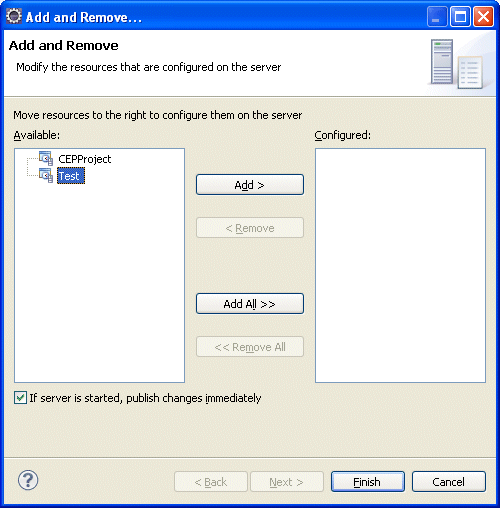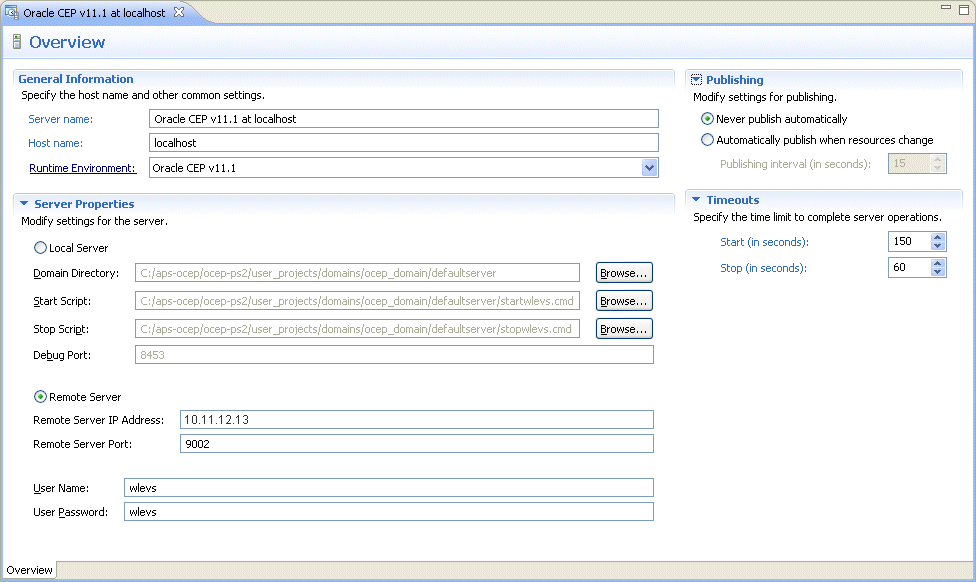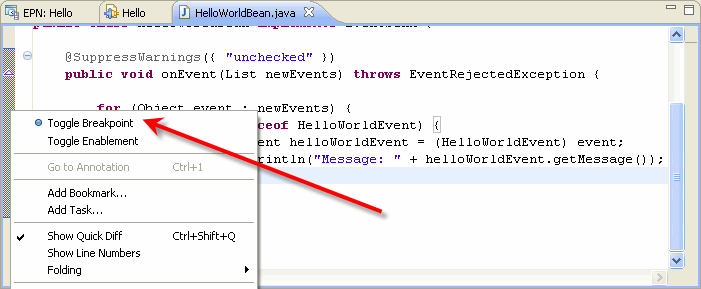6 Oracle Event Processing IDE for Eclipse and Oracle Event Processing Servers
This chapter describes how to use the Oracle Event Processing IDE for Eclipse to create and manage Oracle Event Processing servers to develop and debug event-driven applications.
This chapter includes the following sections:
6.1 Oracle Event Processing Server Overview
The Oracle Event Processing IDE for Eclipse provides features that allow you to set up and manage Oracle Event Processing servers that are used during development. These tools help you to:
-
Configure instances of Oracle Event Processing servers
-
Attach to external Oracle Event Processing server instances
-
Manage Oracle Event Processing server lifecycle with start, stop, and debug commands
-
Associate applications with and deploy applications to Oracle Event Processing servers during development
Table 6-1 maps Eclipse terminology used by the Oracle Event Processing IDE for Eclipse to Oracle Event Processing server terminology.
Table 6-1 Eclipse and Oracle Event Processing Server Concepts
| Eclipse IDE Concept | Oracle Event Processing Server Concept | Description |
|---|---|---|
|
Runtime |
Oracle Event Processing server installation |
The Oracle Event Processing IDE for Eclipse has the concept of a runtime. The runtime defines the location where the Oracle Event Processing IDE for Eclipse can find the installation of a particular Oracle Event Processing server. This information is used to find JAR files and OSGi bundles to add to the project classpath and to further define Servers and Server Instances. Note that a Runtime is not itself a runnable artifact. |
|
Server and Server Instance |
Domain |
The Oracle Event Processing IDE for Eclipse uses the term Server to describe an actual runnable Oracle Event Processing server instance. You can think of it as something that has start scripts, for example. In Oracle Event Processing server terminology, this equates to a Domain. When you set up a server, you specify the domain that this instance will run. For more information on domains, see:
|
|
Publish |
Deploy |
The Oracle Event Processing IDE for Eclipse typically uses the term Publish to describe physically deploying an application to a server. |
|
Project |
Application or Deployment |
A project in the Oracle Event Processing IDE for Eclipse becomes a single Oracle Event Processing application packaged as an OSGi bundle. It is deployed to a server and shows in the Oracle Event Processing server's |
Server definitions are the central concept in controlling an Oracle Event Processing server from the Oracle Event Processing IDE for Eclipse. It is from the server definition that you start and stop the server. After associating a project with the server, you can publish (deploy) the application to and unpublish (undeploy) the application from the server, all without having to leave the Oracle Event Processing IDE for Eclipse. For more information, see Section 6.2, "Creating Oracle Event Processing Servers".
You can communicate with a running Oracle Event Processing server using Oracle Event Processing IDE for Eclipse in the following ways:
-
Start a server from within Oracle Event Processing IDE for Eclipse.
In this case, the Oracle Event Processing server console is sent directly to the console view in Oracle Event Processing IDE for Eclipse. All of the Oracle Event Processing server features (such as start, stop, publish, unpublish, debug, and launching the Oracle Event Processing Visualizer) are available. The Oracle Event Processing server process itself is managed from within Oracle Event Processing IDE for Eclipse. In other words, stopping the Oracle Event Processing server from the Oracle Event Processing IDE for Eclipse will terminate the actual Oracle Event Processing server process. Console messages from the Oracle Event Processing server are sent to the Oracle Event Processing IDE for Eclipse Console view.
For more information, see:
-
Attach to a running Oracle Event Processing server.
In this case, the user starts the Oracle Event Processing server from the command line, then clicks the Start button for that server in Oracle Event Processing IDE for Eclipse. A dialog is shown asking whether or not to attach and, if the user clicks Yes, Oracle Event Processing IDE for Eclipse enters attached mode. All of the Oracle Event Processing server features except debug are available. However, the Oracle Event Processing server process is not managed by the Oracle Event Processing IDE for Eclipse. Clicking the Stop button simply disconnects from the attached Oracle Event Processing server; it does not terminate the actual Oracle Event Processing server process. Console messages from the Oracle Event Processing server are sent to the Oracle Event Processing server console (standard output to the terminal window in which it is running). Oracle Event Processing IDE for Eclipse only shows limited Oracle Event Processing IDE for Eclipse operation messages in the console view.
For more information, see:
6.2 Creating Oracle Event Processing Servers
Creating a server allows you to start and stop the server instance from within the Oracle Event Processing IDE for Eclipse, as well as automatically deploy your applications to that server.
You can create a local or remote Oracle Event Processing server:
-
Local server: a local Oracle Event Processing server is one in which both the server and server runtime are on the same host
-
Remote server: a remote Oracle Event Processing server is one in which the server and server runtime are on different hosts. The server is on a remote host and the server runtime is on the local host (the host on which you are executing the Oracle Event Processing IDE for Eclipse).
This section describes:
-
Section 6.2.1, "How to Create a Local Oracle Event Processing Server and Server Runtime"
-
Section 6.2.2, "How to Create a Remote Oracle Event Processing Server and Server Runtime"
-
Section 6.2.3, "How to Create an Oracle Event Processing Server Runtime"
6.2.1 How to Create a Local Oracle Event Processing Server and Server Runtime
This section describes how to create both a local server and server runtime. After creating the initial server and server runtime, you can create additional server runtimes.
A local Oracle Event Processing server is one in which both the server and server runtime are on the same host. Alternatively, you can create a remote server and server runtime.
Note:
If the server you're creating in Eclipse is one you created from a domain with the Configuration Wizard, be sure to run the server from the command line before adding the server to your Eclipse project. Doing so will ensure that all server artifacts are created. Also, when specifying domain configuration information in the Eclipse New Server wizard, be sure to click the Advanced tab to specify the user name and password used when creating the domain.
For more information on running a server from the command line, see "Starting and Stopping an Oracle Event Processing Server in a Standalone-Server Domain" in Oracle Fusion Middleware Administrator's Guide for Oracle Event Processing.
For more information, see:
-
Section 6.2.3, "How to Create an Oracle Event Processing Server Runtime"
-
Section 6.2.2, "How to Create a Remote Oracle Event Processing Server and Server Runtime"
To create a local Oracle Event Processing server and server runtime:
-
Select Window > Show View > Servers.
The Servers view appears as shown in Figure 6-1.
Figure 6-1 Oracle Event Processing IDE for Eclipse Server View

Description of "Figure 6-1 Oracle Event Processing IDE for Eclipse Server View"
-
Right-click in the Servers view pane and select New > Server.
-
Consider whether or not server runtimes have been created:
-
If this is the first time you have created an Oracle Event Processing server, there will be no installed server runtimes:
In this case, the New Server: Define New Server dialog appears as Figure 6-2 shows.
Figure 6-2 New Server: Define New Server Dialog (No Installed Runtimes)
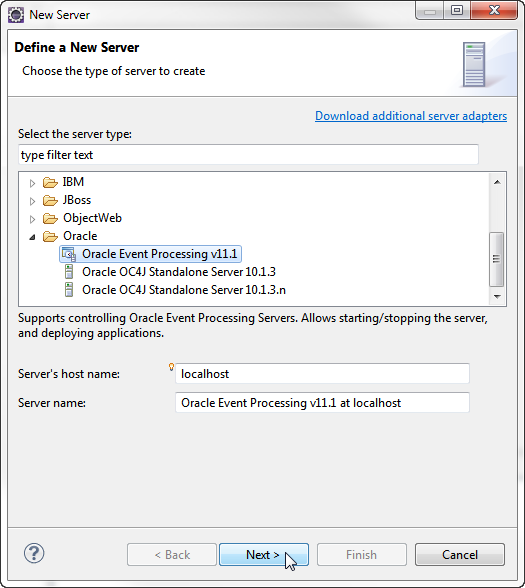
Description of "Figure 6-2 New Server: Define New Server Dialog (No Installed Runtimes)"
Configure the new server as follows:
-
Configure the dialog as shown in Table 6-2.
Table 6-2 New Server: Define New Server Dialog (No Installed Runtimes) Attributes
Attribute Description Server's host name
The host name of the computer on which you installed Oracle Event Processing server.
For development, this will typically be
localhost.Select the server type
The type of Oracle Event Processing server.
In this example, choose
Oracle Event Processing v11Server name
The name of this Oracle Event Processing server.
Default:
Oracle Event Processing v11.1 atHOSTNAMEWhere
HOSTNAMEis the value you entered in the Server's host name field. -
Click Next.
The New Server: New Oracle Event Processing v11 Runtime dialog appears as shown in Figure Figure 6-3.
Figure 6-3 New Server: New Oracle Event Processing v11.1 Runtime Dialog
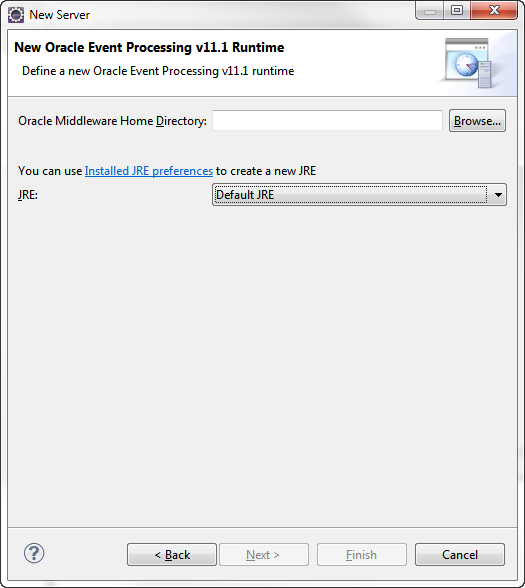
Description of "Figure 6-3 New Server: New Oracle Event Processing v11.1 Runtime Dialog"
-
Configure the dialog as shown in Table 6-3.
Table 6-3 New Server: New Oracle Event Processing v11 Runtime Dialog Attributes
Attribute Description Oracle Middleware Home Directory
The fully qualified path to the Oracle Event Processing server installation directory. This is the same as the "Middleware Home" that was selected when installing the server.
When selecting this directory, select the directory that contains the Oracle Event Processing installation rather than the Oracle Event Processing directory itself. For example, choose:
C:\OracleCEP
But do not choose:
C:\OracleCEP\ocep_11.1
The runtime wizard will use the installation to find the appropriate Oracle Event Processing installation directory.
For more information, see "Oracle Fusion Middleware Directory Structure and Concepts" in the Oracle Fusion Middleware Getting Started Guide for Oracle Event Processing.
JRE
The type of JRE to use.
Select the type of JRE to use from the pull-down menu or click the Installed JRE preferences link to create a new JRE.
Be sure to choose a Java 6 JRE.
NOTE: The Oracle Event Processing server JRE is ultimately set by the
JAVA_HOMEsetting insetDomainEnv.cmdorsetDomainEnv.shscript in the server domain directory. -
Proceed to step 6.
-
-
If this is not the first time you have created an Oracle Event Processing server, there will be one or more installed server runtimes.
In this case, the New Server: Define New Server dialog appears as Figure 6-4 shows.
Figure 6-4 New Server: Define New Server (Installed Runtimes) Dialog
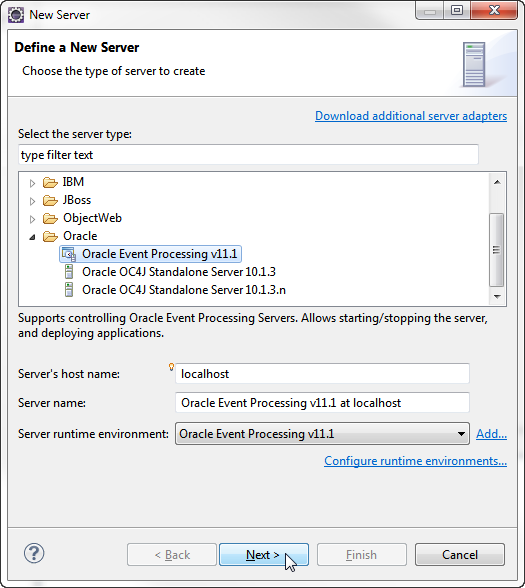
Description of "Figure 6-4 New Server: Define New Server (Installed Runtimes) Dialog"
Configure the dialog as shown in Table 6-4.
Table 6-4 New Server: Define New Server (Installed Runtimes) Dialog Attributes
Attribute Description Server's host name
The host name of the computer on which you installed Oracle Event Processing server.
For development, this will typically be
localhost.Select the server type
The type of Oracle Event Processing server.
In this example, choose
Oracle Event Processing v11.Server runtime
Select the server runtime from the pull-down menu.
To create or edit server runtimes, click Installed Runtimes. For more information, see Section 6.2.3, "How to Create an Oracle Event Processing Server Runtime".
-
The New Server: New Oracle Event Processing v11.1 Server dialog appears as Figure 6-5 shows.
Figure 6-5 New Server: New Oracle Event Processing v11.1 Server
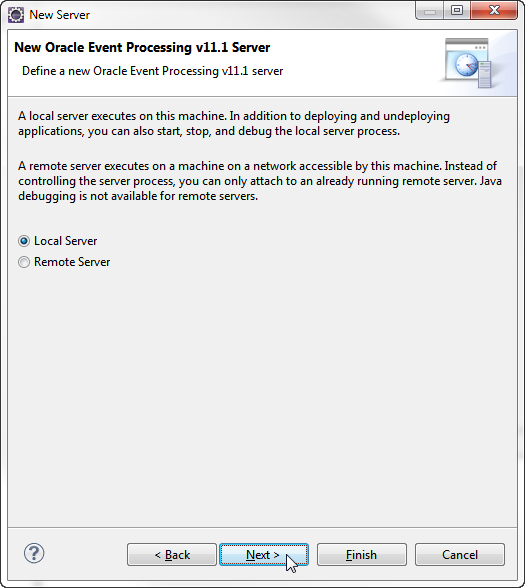
Description of "Figure 6-5 New Server: New Oracle Event Processing v11.1 Server"
-
Select Local Server.
-
Click Next.
The New Server: New Oracle Event Processing v11 Server dialog appears as Figure 6-6 shows.
Figure 6-6 New Server: New Oracle Event Processing v11 Server Dialog for a Local Server
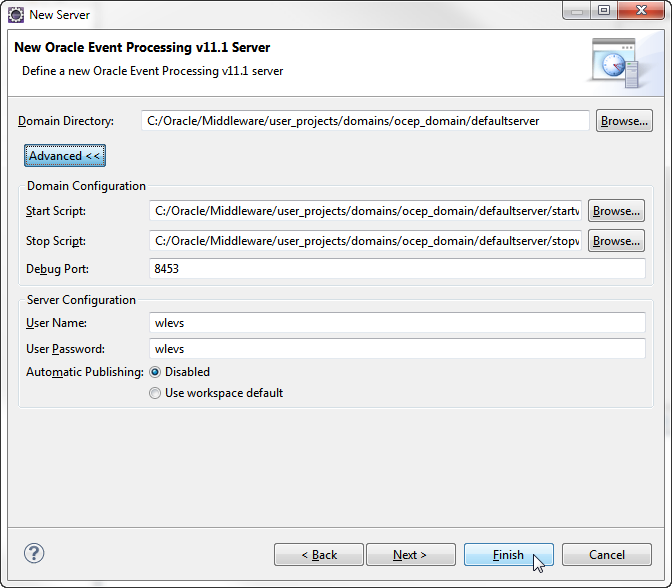
Description of "Figure 6-6 New Server: New Oracle Event Processing v11 Server Dialog for a Local Server"
-
Click Advanced and configure the dialog as shown in Table 6-5.
Table 6-5 New Server: New Oracle Event Processing v11 Server Dialog Attributes for a Local Server
Attribute Description Domain Directory
The fully qualified path to the directory that contains the domain for this server.
Click Browse to choose the directory.
Default:
MIDDLEWARE_HOME\user_projects\domains\ocep_domain\defaultserver.Start Script
The script that Oracle Event Processing IDE for Eclipse uses to start the Oracle Event Processing server.
Default on UNIX:
MIDDLEWARE_HOME/user_projects/domains/ocep_domain/defaultserver/startwlevs.shDefault on Windows:
MIDDLEWARE_HOME\user_projects\domains\ocep_domain\defaultserver\startwlevs.cmdStop Script
The script that Oracle Event Processing IDE for Eclipse uses to stop the Oracle Event Processing server.
Default on UNIX:
MIDDLEWARE_HOME/user_projects/domains/ocep_domain/defaultserver/stopwlevs.shDefault on Windows:
MIDDLEWARE_HOME\user_projects\domains\ocep_domain\defaultserver\stopwlevs.cmdDebug Port
The Oracle Event Processing server port that Oracle Event Processing IDE for Eclipse connects to when debugging the Oracle Event Processing server.
Default: 8453.
User Name
The user name Oracle Event Processing IDE for Eclipse uses when logging into the Oracle Event Processing server.
Default:
wlevs.User Password
The user password Oracle Event Processing IDE for Eclipse uses when logging into the Oracle Event Processing server.
Default:
wlevs.Automatic Publishing
By default, when you change an application, you must manually publish the changes to the Oracle Event Processing server.
Select Use Workspace Default to configure Oracle Event Processing IDE for Eclipse to automatically publish changes to the Oracle Event Processing server.
Default:
Disabled. -
Click Finish.
-
If you configured Automatic Publishing to Use Workspace Default, select Windows > Preferences.
-
Select the Server option.
-
Configure your automatic publishing options:
-
Automatically publish to local servers: enable or disable this option, as required.
Default: enabled.
-
Publishing interval: configure the frequency at which the Oracle Event Processing IDE for Eclipse publishes changes to the server (in seconds).
Default: 60 seconds.
-
-
Automatically publish to remote servers: enable or disable this option, as required.
Default: enabled.
-
Publishing interval: configure the frequency at which the Oracle Event Processing IDE for Eclipse publishes changes to the server (in seconds).
Default: 60 seconds.
-
-
-
Click OK.
6.2.2 How to Create a Remote Oracle Event Processing Server and Server Runtime
This section describes how to create both a remote server and server runtime. After creating the initial server and server runtime, you can create additional server runtimes.
A remote Oracle Event Processing server is one in which the server and server runtime are on different hosts. The server is on a remote host and the server runtime is on the local host (the host on which you are executing the Oracle Event Processing IDE for Eclipse).
Alternatively, you can create a local server and server runtime.
For more information, see:
-
Section 6.2.3, "How to Create an Oracle Event Processing Server Runtime"
-
Section 6.2.1, "How to Create a Local Oracle Event Processing Server and Server Runtime"
To create a remote Oracle Event Processing server and server runtime:
-
Select Window > Show View > Servers.
The Servers view appears as shown in Figure 6-1.
Figure 6-7 Oracle Event Processing IDE for Eclipse Server View

Description of "Figure 6-7 Oracle Event Processing IDE for Eclipse Server View"
-
Right-click in the Servers view pane and select New > Server.
-
Consider whether or not server runtimes have been created:
-
If this is the first time you have created an Oracle Event Processing server, there will be no installed server runtimes:
In this case, the New Server: Define New Server dialog appears as Figure 6-2 shows.
Figure 6-8 New Server: Define New Server Dialog (No Installed Runtimes)

Description of "Figure 6-8 New Server: Define New Server Dialog (No Installed Runtimes)"
Configure the new server as follows:
-
Configure the dialog as shown in Table 6-2.
Table 6-6 New Server: Define New Server Dialog (No Installed Runtimes) Attributes
Attribute Description Server's host name
The host name of the computer on which you installed Oracle Event Processing server.
For development, this will typically be
localhost.Select the server type
The type of Oracle Event Processing server.
In this example, choose
Oracle Event Processing v11Server name
The name of this Oracle Event Processing server.
Default:
Oracle Event Processing v11.1 atHOSTNAMEWhere
HOSTNAMEis the value you entered in the Server's host name field. -
Click Next.
The New Server: New Oracle Event Processing v11 Runtime dialog appears as shown in Figure Figure 6-3.
Figure 6-9 New Server: New Oracle Event Processing v11.1 Runtime Dialog

Description of "Figure 6-9 New Server: New Oracle Event Processing v11.1 Runtime Dialog"
-
Configure the dialog as shown in Table 6-3.
Table 6-7 New Server: New Oracle Event Processing v11 Runtime Dialog Attributes
Attribute Description Oracle Middleware Home Directory
The fully qualified path to the Oracle Event Processing server installation directory. This is the same as the "Middleware Home" that was selected when installing the server.
When selecting this directory, select the directory that contains the Oracle Event Processing installation rather than the Oracle Event Processing directory itself. For example, choose:
C:\OracleCEP
But do not choose:
C:\OracleCEP\ocep_11.1
The runtime wizard will use the installation to find the appropriate Oracle Event Processing installation directory.
For more information, see "Oracle Fusion Middleware Directory Structure and Concepts" in the Oracle Fusion Middleware Getting Started Guide for Oracle Event Processing.
JRE
The type of JRE to use.
Select the type of JRE to use from the pull-down menu or click the Installed JRE preferences link to create a new JRE.
Be sure to choose a Java 6 JRE.
NOTE: The Oracle Event Processing server JRE is ultimately set by the
JAVA_HOMEsetting insetDomainEnv.cmdorsetDomainEnv.shscript in the server domain directory. -
Proceed to step 6.
-
-
If this is not the first time you have created an Oracle Event Processing server, there will be one or more installed server runtimes.
In this case, the New Server: Define New Server dialog appears as Figure 6-4 shows.
Figure 6-10 New Server: Define New Server (Installed Runtimes) Dialog

Description of "Figure 6-10 New Server: Define New Server (Installed Runtimes) Dialog"
Configure the new server as follows:
Table 6-8 New Server: Define New Server (Installed Runtimes) Dialog Attributes
Attribute Description Server's host name
The host name of the computer on which you installed Oracle Event Processing server.
For development, this will typically be
localhost.Select the server type
The type of Oracle Event Processing server.
In this example, choose
Oracle Event Processing v11.Server runtime
Select the server runtime from the pull-down menu.
To create or edit server runtimes, click Installed Runtimes. For more information, see Section 6.2.3, "How to Create an Oracle Event Processing Server Runtime".
-
The New Server: New Oracle Event Processing v11.1 Server dialog appears as Figure 6-5 shows.
Figure 6-11 New Server: New Oracle Event Processing v11.1 Server

Description of "Figure 6-11 New Server: New Oracle Event Processing v11.1 Server"
-
Select Remote Server.
-
Click Next.
The New Server: New Oracle Event Processing v11 Server dialog appears dialog appears as Figure 6-12 shows.
Figure 6-12 New Server: New Oracle Event Processing v11 Server Dialog for a Remote Server
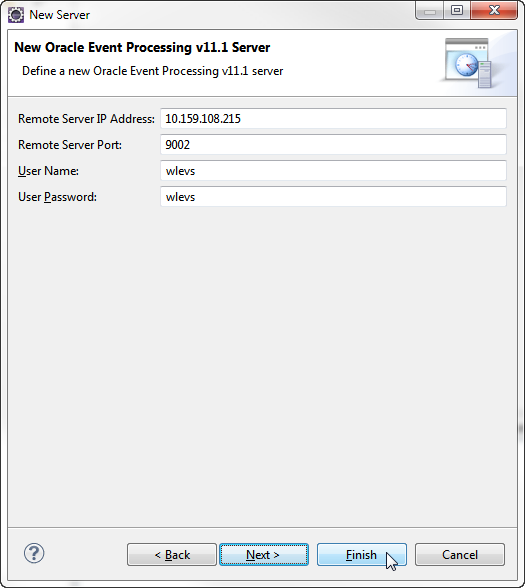
Description of "Figure 6-12 New Server: New Oracle Event Processing v11 Server Dialog for a Remote Server"
-
Configure the dialog as shown in Table 6-9.
Table 6-9 New Server: Oracle Event Processing v11 Server Dialog Attributes for a Local Server
Attribute Description Remote Server IP Address
The IP address of the remote Oracle Event Processing server.
Default: IP address of localhost.
Remote Server Port
The port you specified in the remote Oracle Event Processing server
DOMAIN_DIR/config/config.xmlfile that describes your Oracle Event Processing domain, whereDOMAIN_DIRrefers to your domain directory.The port number is the value of the
Portchild element of theNetioelement:<Netio> <Name>NetIO</Name> <Port>9002</Port> </Netio>Default:
9002User Name
The user name that the Oracle Event Processing IDE for Eclipse uses to log into the remote server.
Default:
wlevsUser Password
The password that the Oracle Event Processing IDE for Eclipse uses to log into the remote server.
Default:
wlevs -
Click Finish.
6.2.3 How to Create an Oracle Event Processing Server Runtime
Before you can create a server, you must configure the Oracle Event Processing IDE for Eclipse with the location of your Oracle Event Processing server installation by creating a server runtime using the runtime wizard. You can access the runtime wizard from several places including the new server wizard, the new project wizard, and the workspace preferences dialog.
You only need to create a runtime explicitly if you have not yet created an Oracle Event Processing server.
For more information, see:
-
Section 6.2.1, "How to Create a Local Oracle Event Processing Server and Server Runtime"
-
Section 6.2.2, "How to Create a Remote Oracle Event Processing Server and Server Runtime"
To create an Oracle Event Processing server runtime:
-
Select Windows > Preferences.
The Preferences dialog appears as Figure 6-13 shows.
Figure 6-13 Preferences - Server - Installed Runtimes
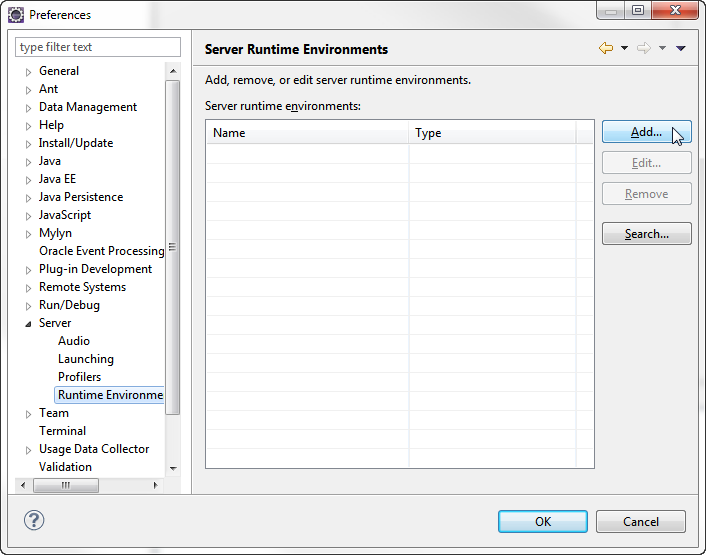
Description of "Figure 6-13 Preferences - Server - Installed Runtimes"
-
Expand the Server option and select Runtime Environments.
-
Click Add.
The New Server Runtime Environment dialog appears as shown in Figure 6-14.
Figure 6-14 New Server Runtime Environment Dialog
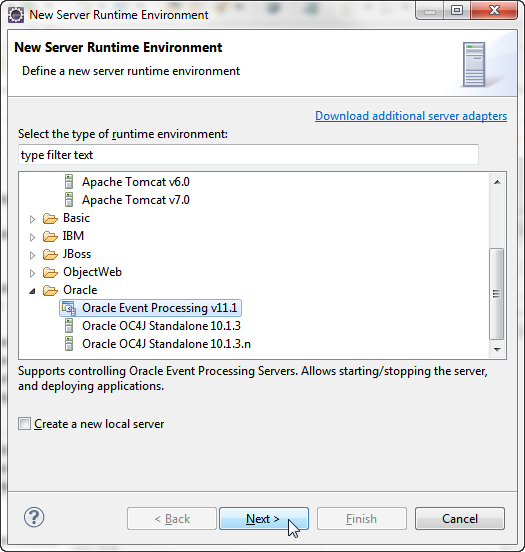
Description of "Figure 6-14 New Server Runtime Environment Dialog"
-
Configure the dialog as shown in Table 6-10.
Table 6-10 New Server Runtime Dialog Attributes
Attribute Description Select the type of runtime environment
The type of Oracle Event Processing server.
In this example, choose
Oracle Event Processing v11.1.Create a new local server
Optionally, check this to create a new local server if you have not yet created a server. For more information, see Section 6.2.1, "How to Create a Local Oracle Event Processing Server and Server Runtime".
-
Click Next.
The New Server Runtime Environment dialog appears as shown in Figure 6-15.
Figure 6-15 New Server Runtime Environment: New Oracle Event Processing v11.1 Runtime Dialog

Description of "Figure 6-15 New Server Runtime Environment: New Oracle Event Processing v11.1 Runtime Dialog"
-
Configure the dialog as shown in Table 6-11.
Table 6-11 New Server Runtime Dialog Attributes
Attribute Description Oracle Middleware Home Directory
The fully qualified path to the Oracle Event Processing server installation directory. This is the same as the "Middleware Home" that was selected when installing the server.
When selecting this directory, select the directory that contains the Oracle Event Processing installation rather than the Oracle Event Processing directory itself. For example, choose:
C:\OracleCEP
But do not choose:
C:\OracleCEP\ocep_11.1
The runtime wizard will use the installation to find the appropriate Oracle Event Processing installation directory.
For more information, see "Oracle Fusion Middleware Directory Structure and Concepts" in the Oracle Fusion Middleware Getting Started Guide for Oracle Event Processing.
JRE
The type of JRE to use.
Select the type of JRE to use from the pull-down menu or click the Installed JRE preferences link to create a new JRE.
Be sure to choose either JRockit Real Time or the JRockit JDK installed with your Oracle Event Processing installation.
-
Click Finish.
6.3 Managing Oracle Event Processing Servers
Using the Oracle Event Processing IDE for Eclipse and the Oracle Event Processing Visualizer accessible from the Oracle Event Processing IDE for Eclipse, you can manage many aspects of your Oracle Event Processing server during development.
This section describes the following Oracle Event Processing server management tasks you can perform from the Oracle Event Processing IDE for Eclipse:
-
Section 6.3.1, "How to Start a Local Oracle Event Processing Server"
-
Section 6.3.2, "How to Stop a Local Oracle Event Processing Server"
-
Section 6.3.3, "How to Attach to an Existing Local Oracle Event Processing Server Instance"
-
Section 6.3.4, "How to Attach to an Existing Remote Oracle Event Processing Server Instance"
-
Section 6.3.5, "How to Detach From an Existing Oracle Event Processing Server Instance"
-
Section 6.3.6, "How to Deploy an Application to an Oracle Event Processing Server"
-
Section 6.3.7, "How to Configure Connection and Control Settings for Oracle Event Processing Server"
-
Section 6.3.8, "How to Configure Domain (Runtime) Settings for Oracle Event Processing Server"
6.3.1 How to Start a Local Oracle Event Processing Server
After you create a local server, you can start the Oracle Event Processing server from the Oracle Event Processing IDE for Eclipse.
You can also start the local Oracle Event Processing server in debug mode.
Alternatively, you can start the local Oracle Event Processing server from the command line and attach to it using Oracle Event Processing IDE for Eclipse.
For more information, see:
-
Section 6.2.1, "How to Create a Local Oracle Event Processing Server and Server Runtime"
-
Section 6.3.3, "How to Attach to an Existing Local Oracle Event Processing Server Instance"
To start a local Oracle Event Processing server:
-
Select Window > Show Views > Servers.
The Servers view opens as shown in Figure 6-16.
Figure 6-16 Starting an Oracle Event Processing Server
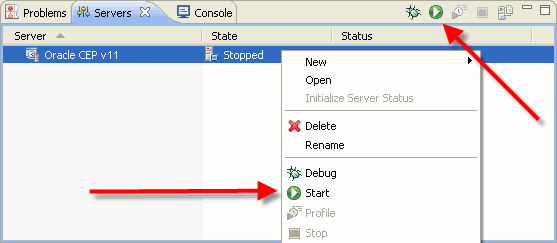
Description of "Figure 6-16 Starting an Oracle Event Processing Server"
-
Start the server by choosing one of the following:
-
Click the Start the Server icon in the Servers view tool bar.
-
Right-click a server in the Servers view and select Start.
After starting the server you will see log messages from the server in the Console view.
-
6.3.2 How to Stop a Local Oracle Event Processing Server
After you start a local Oracle Event Processing server from the Oracle Event Processing IDE for Eclipse, you can stop the Oracle Event Processing server from the Oracle Event Processing IDE for Eclipse.
Note that stopping the Oracle Event Processing while Oracle Event Processing Visualizer is running might produce console messages indicating that a service proxy has been destroyed. This is generally an informational message only.
For more information, see Section 6.3.1, "How to Start a Local Oracle Event Processing Server".
To stop a local Oracle Event Processing server:
-
Select Window > Show Views > Servers.
The Servers view opens as shown in Figure 6-17.
Figure 6-17 Stopping an Oracle Event Processing Server
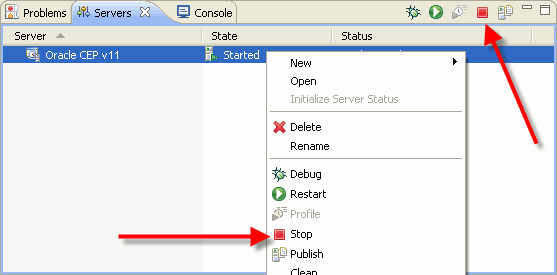
Description of "Figure 6-17 Stopping an Oracle Event Processing Server"
-
Stop the server by choosing one of the following:
-
Click the Stop the Server icon in the Servers view tool bar.
-
Right-click a server in the Servers view and select Stop.
-
6.3.3 How to Attach to an Existing Local Oracle Event Processing Server Instance
After you create a local server, you can start the local Oracle Event Processing server from the command line and attach Oracle Event Processing IDE for Eclipse to this existing, already running local Oracle Event Processing server instance.
Alternatively, you can start the local Oracle Event Processing server directly from within Oracle Event Processing IDE for Eclipse.
For more information, see:
-
Section 6.2.1, "How to Create a Local Oracle Event Processing Server and Server Runtime"
-
Section 6.3.1, "How to Start a Local Oracle Event Processing Server"
To attach to an existing local Oracle Event Processing server instance:
-
Start the Oracle Event Processing server from the command line.
For more information, see "Starting and Stopping Oracle Event Processing Servers" in the Oracle Fusion Middleware Administrator's Guide for Oracle Event Processing.
-
Select Window > Show Views > Servers.
The Servers view opens as shown in Figure 6-16.
Figure 6-18 Attaching to an Existing Local Oracle Event Processing Server Instance

Description of "Figure 6-18 Attaching to an Existing Local Oracle Event Processing Server Instance"
-
Attach to the already running local server by choosing one of the following:
-
Click the Start the Server icon in the Servers view tool bar.
-
Right-click a server in the Servers view and select Start.
The Attach to Running OEP Server dialog appears.
-
-
Click Yes.
After attaching to the server you will not see log messages from the server in the Console view.
You can view the server console using the Oracle Event Processing Visualizer. For more information, see "How to View Console Output" in the Oracle Fusion Middleware Visualizer User's Guide for Oracle Event Processing.
6.3.4 How to Attach to an Existing Remote Oracle Event Processing Server Instance
After you create a remote server, you can start the remote Oracle Event Processing server from the command line and attach Oracle Event Processing IDE for Eclipse to this existing, already running remote Oracle Event Processing server instance.
For more information, see Section 6.2.2, "How to Create a Remote Oracle Event Processing Server and Server Runtime".
To attach to an existing remote Oracle Event Processing server instance:
-
Start the remote Oracle Event Processing server from the command line.
For more information, see "Starting and Stopping Oracle Event Processing Servers" in the Oracle Fusion Middleware Administrator's Guide for Oracle Event Processing.
-
Select Window > Show Views > Servers.
The Servers view opens as shown in Figure 6-16.
Figure 6-19 Attaching to an Existing Remote Oracle Event Processing Server Instance

Description of "Figure 6-19 Attaching to an Existing Remote Oracle Event Processing Server Instance"
-
Attach to the already running remote server by choosing one of the following:
-
Click the Start the Server icon in the Servers view tool bar.
-
Right-click a server in the Servers view and select Start.
After attaching to the remote server, Oracle Event Processing IDE for Eclipse writes one status message to the Console view, reading:
[3/23/10 12:32 PM] Attached to remote OEP server at address 10.11.12.13 and port 9002
You will not see log messages from the remote server in the Console view.
You can view the server console using the Oracle Event Processing Visualizer. For more information, see "How to View Console Output" in the Oracle Fusion Middleware Visualizer User's Guide for Oracle Event Processing.
-
6.3.5 How to Detach From an Existing Oracle Event Processing Server Instance
After you attach to an existing, running Oracle Event Processing server instance, you can detach from the Oracle Event Processing server and leave it running.
For more information, see:
-
Section 6.3.3, "How to Attach to an Existing Local Oracle Event Processing Server Instance"
-
Section 6.3.4, "How to Attach to an Existing Remote Oracle Event Processing Server Instance"
To detach from an existing Oracle Event Processing server instance:
-
Select Window > Show Views > Servers.
The Servers view opens as shown in Figure 6-17.
Figure 6-20 Stopping an Oracle Event Processing Server

Description of "Figure 6-20 Stopping an Oracle Event Processing Server"
-
Detach from the server by choosing one of the following:
-
Click the Stop the Server icon in the Servers view tool bar.
-
Right-click a server in the Servers view and select Stop.
Oracle Event Processing IDE for Eclipse detaches from the Oracle Event Processing server instance. The Oracle Event Processing server instance continues to run.
If you detach from a remote Oracle Event Processing server, Oracle Event Processing IDE for Eclipse writes a log message to the Console view reading:
[3/23/10 12:47 PM] Server communication stopped
-
6.3.6 How to Deploy an Application to an Oracle Event Processing Server
A project in the Oracle Event Processing IDE for Eclipse is built as an Oracle Event Processing application, then deployed to the server. To deploy an application, a server must first be defined. To then deploy an application, simply add it to the server. The application will be deployed immediately if the server is already started, or when the server is next started if the server is stopped.
For more information, see:
-
Section 6.2.1, "How to Create a Local Oracle Event Processing Server and Server Runtime"
-
Section 6.2.2, "How to Create a Remote Oracle Event Processing Server and Server Runtime"
To deploy an application to an Oracle Event Processing server:
-
Create an Oracle Event Processing project (see Section 5.2, "Creating Oracle Event Processing Projects").
-
Create a server (see Section 6.2.1, "How to Create a Local Oracle Event Processing Server and Server Runtime").
-
Select Window > Show Views > Servers.
The Servers view opens as shown in Figure 6-21.
Figure 6-21 Adding a Project to an Oracle Event Processing Server
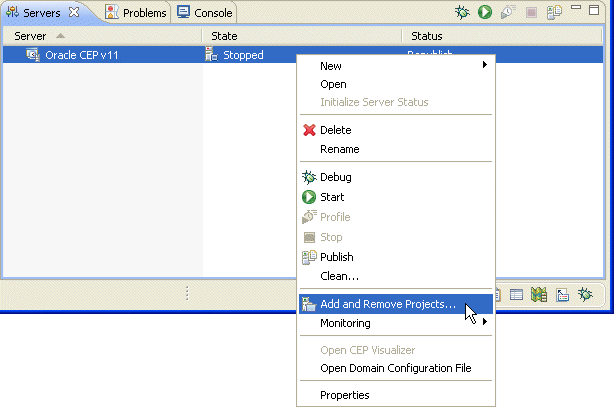
Description of "Figure 6-21 Adding a Project to an Oracle Event Processing Server"
-
Right-click the server and select Add and Remove.
The Add and Remove dialog appears as shown in Figure 6-22.
-
Configure the dialog as Table 6-12 shows.
Table 6-12 Add and Remove Dialog Attributes
Attribute Description Available
Select one or more projects from this list and click Add or Add All to move them into the Configured list.
Configured
Select one or more projects from this list and click Remove or Remove All to move them into the Available list.
If server is started, publish changes immediately.
Check this option to immediately publish projects that you modify. Applicable only if the server is already running.
-
Click Finish.
Once an application is added, it will show as a child of the server in the Servers view as shown in Figure 6-23.
Figure 6-23 Server View After Adding a Project

Description of "Figure 6-23 Server View After Adding a Project"
-
To deploy (publish) the application to the Oracle Event Processing server, right-click the added application and select Force Publish.
-
If the Oracle Event Processing server is part of a standalone-server, domain the application is deployed.
-
If the Oracle Event Processing server is part of a multi-server domain, the Select Cluster Deployment Group Name dialog appears as Figure 6-24 shows.
Figure 6-24 Select Cluster Deployment Group Name Dialog

Description of "Figure 6-24 Select Cluster Deployment Group Name Dialog"
Select the cluster deployment group you want to deploy the application to and click OK.
For more information on clustering, see "Introduction to Multi-Server Domains" in the Oracle Fusion Middleware Administrator's Guide for Oracle Event Processing.
Once an application is deployed (published), it will show as a child of the server in the Servers view as shown in Figure 6-25.
Figure 6-25 Server View After Deploying (Publishing) a Project

Description of "Figure 6-25 Server View After Deploying (Publishing) a Project"
-
6.3.7 How to Configure Connection and Control Settings for Oracle Event Processing Server
After you create a server, you can use the Server Overview editor to configure all the important server connection and control settings that Oracle Event Processing IDE for Eclipse uses to communicate with the Oracle Event Processing server.
For more information, see:
-
Section 6.2.1, "How to Create a Local Oracle Event Processing Server and Server Runtime"
-
Section 6.3.8, "How to Configure Domain (Runtime) Settings for Oracle Event Processing Server"
To configure connection and control settings for Oracle Event Processing server:
-
Select Window > Show Views > Servers.
-
Double-click a server in the Servers view.
The Server Overview editor opens as shown in Figure 6-26.
-
Configure the Server Overview editor as shown in Table 6-13.
Table 6-13 Server Overview Editor Attributes
Attribute Description Server Name
The name of this server. Only used within the Oracle Event Processing IDE for Eclipse as a useful identifier.
For more information, see Section 6.2.1, "How to Create a Local Oracle Event Processing Server and Server Runtime".
Host Name
The name of the host on which this server is installed.
For more information, see Section 6.2.1, "How to Create a Local Oracle Event Processing Server and Server Runtime".
Runtime Environment
The current installed runtime selected for this server.
Select a new runtime from the pull down menu or click the Edit link to modify the configuration of the selected runtime.
For more information, see Section 6.2.1, "How to Create a Local Oracle Event Processing Server and Server Runtime".
Domain DirectoryFoot 1
The fully qualified path to the directory that contains the domain for this server.
Click Browse to choose the directory.
Default:
MIDDLEWARE_HOME\user_projects\domains\ocep_domain\defaultserver.Start ScriptFootref 1
The script that Oracle Event Processing IDE for Eclipse uses to start the Oracle Event Processing server.
Click Browse to choose the start script.
Default on UNIX:
MIDDLEWARE_HOME\user_projects\domains\ocep_domain\defaultserver\stopwlevs.shDefault on Windows:
MIDDLEWARE_HOME\user_projects\domains\ocep_domain\defaultserver\stopwlevs.cmdStop ScriptFootref 1
The script that Oracle Event Processing IDE for Eclipse uses to stop the Oracle Event Processing server.
Click Browse to choose the stop script.
Default on UNIX:
MIDDLEWARE_HOME\user_projects\domains\ocep_domain\defaultserver\startwlevs.shDefault on Windows:
MIDDLEWARE_HOME\user_projects\domains\ocep_domain\defaultserver\startwlevs.cmdDebug PortFootref 1
The Oracle Event Processing server port that Oracle Event Processing IDE for Eclipse connects to when debugging the Oracle Event Processing server.
Default: 8453.
Remote Server IP AddressFoot 2
The IP address of the remote Oracle Event Processing server.
Default: IP address of localhost.
Remote Server PortFootref 2
The port you specified in the remote Oracle Event Processing server
DOMAIN_DIR/config/config.xmlfile that describes your Oracle Event Processing domain, whereDOMAIN_DIRrefers to your domain directory.The port number is the value of the
Portchild element of theNetioelement:<Netio> <Name>NetIO</Name> <Port>9002</Port> </Netio>Default:
9002User NameFootref 2
The user name that the Oracle Event Processing IDE for Eclipse uses to log into the remote server.
Default:
wlevsUser PasswordFootref 2
The password that the Oracle Event Processing IDE for Eclipse uses to log into the remote server.
Default:
wlevsPublishing
By default, when you change an application, you must manually publish the changes to the Oracle Event Processing server.
Select Never publish automatically to disable automatic publishing.
Select Override default settings to override the default automatic publishing interval. Enter a new publishing interval (in seconds).
Default:
Never publish automatically.Timeouts
Enter a positive, integer number of seconds in the Start (in seconds) field to specify the time in which the Oracle Event Processing server must start.
Default: 150 seconds.
Enter a positive, integer number of seconds in the Stop (in seconds) field to specify the time in which the Oracle Event Processing server must start.
Default: 60 seconds.
Footnote 1 Click Local Server to modify. Applies to both a local server and the runtime of a remote server.
Footnote 2 Click Remote Server to modify. Applies only to a remote server.
-
Select File > Save.
-
Close the Server Overview editor.
6.3.8 How to Configure Domain (Runtime) Settings for Oracle Event Processing Server
After you create a server, you can use the Oracle Event Processing IDE for Eclipse to configure Oracle Event Processing server domain (runtime) settings in the Oracle Event Processing server config.xml file.
Recall that a local Oracle Event Processing server is one in which both the server and server runtime are on the same host and a remote Oracle Event Processing server is one in which the server and server runtime are on different hosts: the server is on a remote host and the server runtime is on the local host (the host on which you are executing the Oracle Event Processing IDE for Eclipse).
For both local and remote Oracle Event Processing servers, when you configure domain (runtime) settings, you are modifying only the Oracle Event Processing server config.xml on the local host.
You can also use the Oracle Event Processing IDE for Eclipse to configure all the important server connection and control settings that Oracle Event Processing IDE for Eclipse uses to communicate with the Oracle Event Processing server.
Any changes you make to the Oracle Event Processing server config.xml file for a running Oracle Event Processing server are not read by the Oracle Event Processing server until you restart it.
If you make changes to the Oracle Event Processing server config.xml file for a running Oracle Event Processing server using the Oracle Event Processing Visualizer, the changes apply to the running Oracle Event Processing server as soon as you save them. The Oracle Event Processing Visualizer updates the Oracle Event Processing server config.xml file and overwrites the current filesystem version of that file with the current, in-memory version.
If you make changes to the Oracle Event Processing server config.xml file by manually editing this file, and you then make further changes using the Oracle Event Processing Visualizer, your manual edits will be overwritten by the Oracle Event Processing Visualizer.
To avoid this, when you manually edit the Oracle Event Processing server config.xml file, always stop and start the Oracle Event Processing server to read those changes into the runtime configuration and then use the Oracle Event Processing Visualizer to make further changes.
For more information, see:
-
Section 6.2.1, "How to Create a Local Oracle Event Processing Server and Server Runtime"
-
Section 6.2.2, "How to Create a Remote Oracle Event Processing Server and Server Runtime"
-
Section 6.3.7, "How to Configure Connection and Control Settings for Oracle Event Processing Server"
-
"Understanding Oracle Event Processing Server Configuration" in the Oracle Fusion Middleware Administrator's Guide for Oracle Event Processing
To configure domain (runtime) settings for Oracle Event Processing server:
-
Select Window > Show Views > Servers.
-
Right-click a server in the Servers view and select Open Domain Configuration File as shown in Figure 6-27.
Figure 6-27 Editing the Domain Configuration File
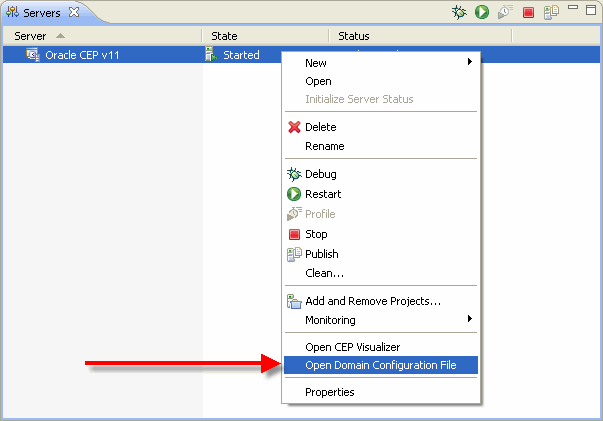
Description of "Figure 6-27 Editing the Domain Configuration File"
The Oracle Event Processing server domain configuration file
config.xmlopens as shown in Figure 6-28.Figure 6-28 Oracle Event Processing Domain Configuration File config.xml

Description of "Figure 6-28 Oracle Event Processing Domain Configuration File config.xml"
-
Edit the domain configuration file as required.
-
Select File > Save.
-
Close the domain configuration file.
6.3.9 How to Start the Oracle Event Processing Visualizer from Oracle Event Processing IDE for Eclipse
After you create a server, you can start the Oracle Event Processing Visualizer from the Oracle Event Processing IDE for Eclipse.
The Oracle Event Processing Visualizer is the administration console for a running Oracle Event Processing server. For more information, see the Oracle Fusion Middleware Visualizer User's Guide for Oracle Event Processing.
For more information, see Section 6.2.1, "How to Create a Local Oracle Event Processing Server and Server Runtime".
Note:
If you use the Oracle Event Processing Visualizer to make changes to the Oracle Event Processing server config.xml (for example, editing a data source), you may overwrite config.xml file changes made manually. For more information, see Section 6.3.8, "How to Configure Domain (Runtime) Settings for Oracle Event Processing Server".
To start the Oracle Event Processing Visualizer from Oracle Event Processing IDE for Eclipse:
-
Start the server (see Section 6.3.1, "How to Start a Local Oracle Event Processing Server").
Note that if you stop the server while Oracle Event Processing Visualizer is running, you might see informational messages about the service proxy. These are typically not errors.
-
Right-click the running server in the Servers view and select Open Oracle Event Processing Visualizer as shown in Figure 6-29.
Figure 6-29 Opening the Oracle Event Processing Visualizer
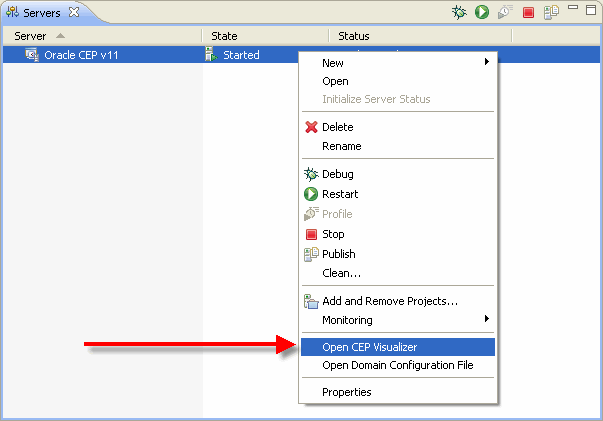
Description of "Figure 6-29 Opening the Oracle Event Processing Visualizer"
The Oracle Event Processing Visualizer opens as shown in Figure 6-30.
Figure 6-30 Oracle Event Processing Visualizer

Description of "Figure 6-30 Oracle Event Processing Visualizer"
-
Use the Oracle Event Processing Visualizer as the Oracle Fusion Middleware Visualizer User's Guide for Oracle Event Processing describes.
6.4 Debugging an Oracle Event Processing Application Running on an Oracle Event Processing Server
Because Oracle Event Processing applications are Java applications, standard Java debugging tools including those provided in Eclipse can be used with these applications.
This section describes:
You can also use the load generator and csvgen adapter to simulate data feeds for testing. For more information, see Chapter 21, "Testing Applications With the Load Generator and csvgen Adapter".
6.4.1 How to Debug an Oracle Event Processing Application Running on an Oracle Event Processing Server
This section describes how to debug an Oracle Event Processing application running on an Oracle Event Processing server.
To debug an Oracle Event Processing application running on an Oracle Event Processing server:
-
Set a breakpoint in the Java code you wish to debug.
In this case, set the breakpoint by right-clicking in the gutter of the editor and selecting Toggle Breakpoint as Figure 6-31 shows.
-
Select Window > Show Views > Servers.
-
Start the server in debug mode by choosing one of the following as shown in Figure 6-32:
-
Click the Start the Server in debug mode icon in the Servers view tool bar.
-
Right-click a server in the Servers view and select Debug.
Figure 6-32 Starting the Oracle Event Processing Server in Debug Mode
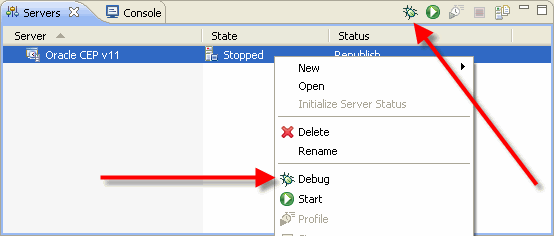
Description of "Figure 6-32 Starting the Oracle Event Processing Server in Debug Mode"
-
-
The server will start, and when it gets to your breakpoint the thread will stop.
If the Oracle Event Processing IDE for Eclipse does not automatically switch to the Debug perspective, switch to that perspective by selecting Window > Open Perspective > Other and selecting the Debug option from the list of perspective.
-
Debug your application using the Debug perspective.
Note:
In some cases you may get a dialog box warning that it could not install a breakpoint because of missing line number information. This dialog comes from the core Eclipse debugger and is normally a harmless issue with Oracle Event Processing Service Engine applications. Simply check the Don't Tell Me Again checkbox and continue debugging.
-
When you are finished you can stop the server as usual (see Section 6.3.2, "How to Stop a Local Oracle Event Processing Server").
